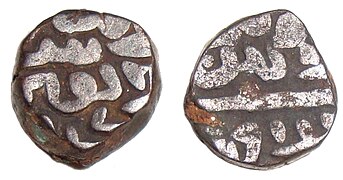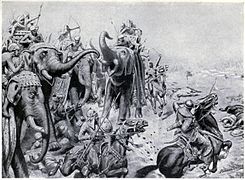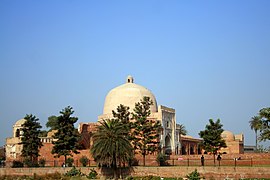Ibrahim Lodhi
| Ibrahim Lodhi | |||||
|---|---|---|---|---|---|
| Sultan of the Lodhi Dynasty | |||||
| 31th Sultan of Delhi | |||||
| Reign | 1517 – 21 April 1526 | ||||
| Coronation | 1517, Agra | ||||
| Predecessor | Sikandar Lodhi | ||||
| Successor | Sultanate abolished By (Babur as Mughal Emperor) | ||||
| Born | 1480[1] Delhi | ||||
| Died | 21 April 1526 (aged 45–46) Panipat, now Haryana, India | ||||
| Burial | Tehsil Office, Panipat | ||||
| |||||
| House | Lodhi dynasty | ||||
| Father | Sikandar Khan Lodhi | ||||
| Religion | Islam | ||||
Ibrahim Khan Lodhi (Persian: ابراهیم خان لودی), (1480 – 21 April 1526) was the last Sultan of the Delhi Sultanate,[2][3] who became Sultan in 1517 after the death of his father Sikandar Lodhi. He was the last ruler of the Lodhi dynasty, reigning for nine years until 1526, when he was defeated and killed at the Battle of Panipat by Babur's invading army, giving way to the emergence of the Mughal Empire in India.[4][5]
Biography[]
Ibrahim was an ethnic Pashtun. He attained the throne upon the death of his father, Sikandar, but was not blessed with the same ruling capability. He faced a number of rebellions. Ibrahim Lodhi also displeased the nobility when he replaced old and senior commanders with younger ones who were loyal to him. His Afghan nobility eventually invited Babur to invade India.
In 1526, the Mughal forces of Babur, the king of Kabulistan (Kabul, present Afghanistan), defeated Ibrahim's much larger army in the Battle of Panipat. He was killed in the battle. It is estimated that Babur's forces numbered around 12,000–25,000 men and had between 20 and 24 pieces of canons. Ibrahim Lodhi had around 50,000 to 120,000 men along with around 400 to 1000 war elephants. In the ensuing battle the Lodhi forces were tarnished with over 20,000 killed and many more wounded and captured. After the end of Lodhi dynasty, the era of Mughal rule commenced for next 331 years.[6]
Tomb[]
His tomb is often mistaken to be the Shisha Gumbad within Lodhi Gardens, Delhi. Rather Ibrahim Lodi's Tomb is actually situated near the tehsil office in Panipat, close to the Dargah of Sufi saint Bu Ali Shah Qalandar. It is a simple rectangular structure on a high platform approached by a flight of steps. In 1866, the British relocated the tomb during construction of the Grand Trunk Road and renovated it with an inscription highlighting Ibrahim Lodi's death in the Battle of Panipat. He also built a Khwaja Khizr Tomb in Sonipat in 1522.[7][8][9]
Gallery[]

An awards ceremony in the Sultan Ibrāhīm's court before being sent on an expedition to Sambhal

1526-First Battle of Panipat-Ibrahim Lodhi and Babur

Quarter Tanka Of Ibrahim Lodhi

Babur introduced field guns at panipat, 1526
Kabuli Bagh Mosque
See also[]
References[]
- ^ "Biography of Ibrahim Lodi | Free PDF Download Studyiq". 30 June 2019.
- ^ Chandra, Satish (2005). Medieval India: From Sultanat to the Mughals Part - II. Har-Anand Publications. ISBN 978-81-241-1066-9.
The first of these was the death of the Afghan ruler , Sikandar Lodi , at Agra towards the end of 1517 and the succession of Ibrahim Lodhi . The second was the conquest of Bajaur and Bhira , by Babur in the frontier tract of north - west Punjab in ...
- ^ Sengupta, Sudeshna. History & Civics 9. Ratna Sagar. p. 126. ISBN 9788183323642.
The Lodi dynasty was established by the Ghilzai tribe of the Afghans
- ^ "SULṬĀN ĪBRAHĪM BIN SULṬĀN SIKANDAR LODHĪ". The Muntakhabu-’rūkh by ‘Abdu-’l-Qādir Ibn-i-Mulūk Shāh, known as Al-Badāoni, translated from the original Persian and edited by George S. A. Ranking, Sir Wolseley Haig and W. H. Lowe. Packard Humanities Institute 1884–1925. Archived from the original on 28 July 2013. Retrieved 18 November 2012.
- ^ Sen, Sailendra (2013). A Textbook of Medieval Indian History. Primus Books. pp. 122–25. ISBN 978-9-38060-734-4.
- ^ Davis, Paul K. (1999), 100 Decisive Battles: From Ancient Times to the Present, Oxford University Press, p181.
- ^ Tomb of Ibrahim Lodi Archived 14 May 2008 at the Wayback Machine
- ^ Ibrahim Lodi's Tomb
- ^ The tale of the missing Lodi tomb The Hindu, 4 July 2005.
External links[]
- 1526 deaths
- Sultans of the Lodi dynasty
- Indian people of Pashtun descent
- People from Panipat
- People from Delhi
- 1517 in India
- 16th-century Indian monarchs
- Indian Muslims
- 1480 births




